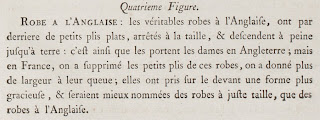Galerie des Modes, 13e Cahier, 4e Figure
Robe à l'Anglaise of apple-green Pekin, the trim of plain gauze with a garland of flowers, a pouf cap of Italian gauze bordered with flowers, the parfait Contentement Pink, the Shoes Pink, and the rosette white. (1778)
Robe à l'Anglaise: the true robes à l'Anglaise have little knife pleats in the back, held at the waist and descending almost to the ground: thus the ladies in England wear them. But in France, the little pleats of these gowns have been removed and been given more width in the tail; on the front they took a more graceful form, and would be better called "fitted-cut" gowns rather than robes à l'Anglaise.
It is one of these changed gowns which the print offers. The trim, in a band of box-pleated gaze de fantaisie, serves to act as a head for a flower garland, stripped of stems and leaves: the openings of the pockets and the sabot cuffs have a matching trim.
Petticoat with a large volant, having for a head a band matching the trim of the gown; a second band, resembling the former, is places above the volant.
 Tasseled watch cord is positioned on the left side; contentement covers the top of the compere and unites the two sides of the gown.
Tasseled watch cord is positioned on the left side; contentement covers the top of the compere and unites the two sides of the gown.Coiffure à la mignarde:* braided chignon, two straight curls, the whole surmounted by a pouf of gaze d'Italie with a double papillon, surrounded by a flower garland matching those of the trim.
Rosettes on the shoes, bracelets, necklace, fan: all show a coquette who has neglected nothing to complete her parure and make it agreeable. She profits for a moment that she finds herself alone, to consider if a negligent air would not be preferable to a too-uniform appearance.
* a mignarde is a sweet, delicate person






Dear Cassidy,
ReplyDeleteI am enjoying this series no end. It's been a terrific education into the minutae of construction and especially naming of the various pieces of an ensemble. Now I can spot volants and contentements, for example, and have a better sense for the subtleties of cut.
With deepest appreciation for all the effort you are putting into the translations. My hat is off to you!
Very best,
Natalie
Natalie, I'm so glad you're enjoying it. While it's not the most accurate lens to view ordinary dress through, there is so much that they show us about the general common ways outfits and clothes are put together and the first appearance of various styles - because obviously ordinary women's clothing can't be more advanced than French aristocrats!
DeleteThank you so much for your kind words.